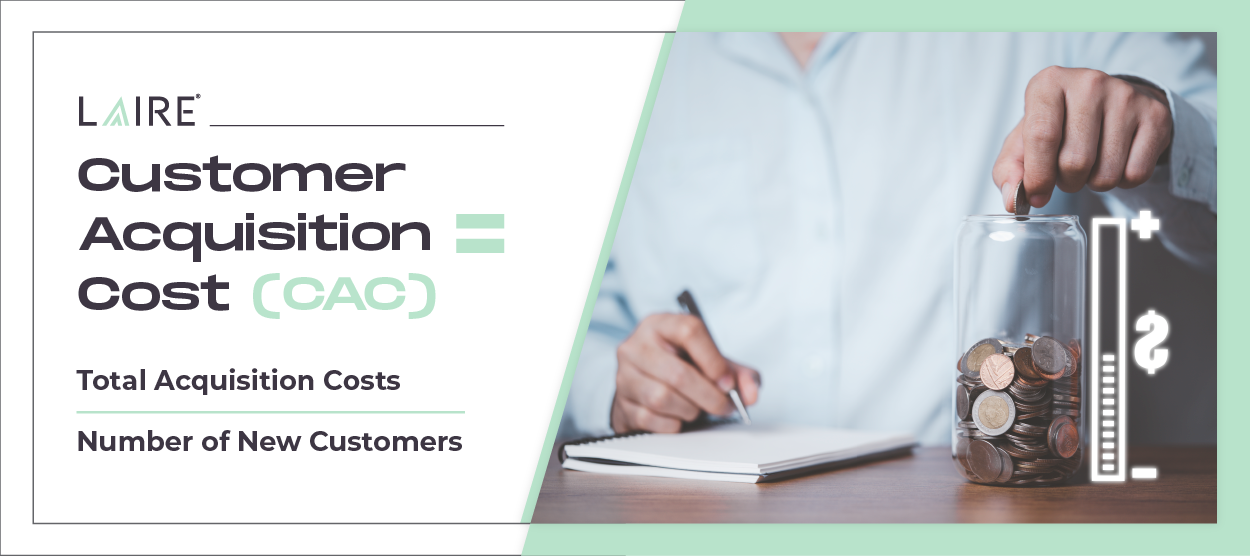In the business world, the competition never rests, and consumer behaviors evolve quickly, often making it difficult to keep up with changing demands. To successfully combat these changes, a well-structured marketing budget is a must for businesses that want to grow their revenue.
So, how much should you spend on marketing? That depends on how big your goals are.

Let’s talk about how to determine the right marketing budget for your business.
The Foundation of a Successful Marketing Budget
When deciding how much to spend on your marketing budget, several steps should be taken to better align that budget with your overall goals and maximize your return on investment (ROI).
First, define your goals. By being clear about what you want to achieve, you’ll have a clear roadmap toward outlining specific and measurable targets for lead generation, customer acquisition, and revenue growth.
Second, you need to allocate resources to different marketing channels based on those goals.
Ask yourself the question: Where does my target audience hang out online? Wherever that is, that’s where you should be. Whether it's paid advertising, organic content marketing, or traditional methods like print ads, each channel should contribute strategically to your overall objectives.
Third, you’ll want to set timely and well-planned campaigns to make sure your marketing efforts are synchronized with seasonal trends, important events within your industry, or product/service launches.
As important as these key steps are, the most important element of a successful marketing budget is its alignment with your overall business goals.
When the marketing budget mirrors your company's objectives, it becomes a powerful tool for driving revenue growth. It ensures that every dollar spent contributes directly to your intended outcomes, whether that be increased brand awareness, higher customer retention, or a surge in sales.
Assessing Your Current Financial Landscape
Start by assessing your existing revenue streams to identify which products or services are driving the majority of your income.
Pinpoint your strengths and areas for improvement, and take into account market demand, customer feedback, and industry trends. At the same time, you’ll want to take an accurate picture of your overall financial health. Consider things like operating expenses, profit margins, and any outstanding debts.
Analyzing the state of your finances in this way provides a stronger foundation for making the right decision about how much to spend on your marketing budget.
Understanding Industry Benchmarks
Looking at what your competitors are doing can offer valuable insights into where they are investing their marketing dollars and why — but you don’t want to copy them outright.
Your stage of growth matters; newer businesses might allocate a higher percentage to establish a brand presence, while established ones might want to focus on optimizing their existing channels.
A good rule of thumb is to allocate a percentage that allows for meaningful impact without compromising on your essential operational needs. Striking the right balance ensures your marketing budget becomes a catalyst for growth without overstepping your financial bandwidth.
Setting Clear Revenue Goals
Don’t be afraid to set ambitious revenue goals. Ambitious yet achievable targets provide a roadmap to guide your business toward greater revenue growth.

When establishing those revenue goals, consider both short-term objectives and long-term goals and align them with your overall business strategy. Any ambiguity in your revenue targets can lead to confusion and misalignment between your expectations and the outcomes that you see.
The critical thing to remember is that your revenue goals and your marketing budget allocation need to work hand in hand.
For example, if your goal is to increase customer acquisition, a portion of the budget may be used for targeted digital advertising or lead-generation campaigns. But if your focus is on increasing customer retention, then investing in things like loyalty programs or personalized marketing initiatives should take precedence.
Here’s where a well-defined revenue target comes into play.
Not only does it inform where to allocate your funds but it also helps in establishing key performance indicators (KPIs) to measure the success of your marketing efforts. This means that every dollar spent contributes directly to revenue generation and helps you make better decisions on how exactly to spend your marketing budget.
Choosing the Right Marketing Channels
Selecting the right mix of marketing channels is crucial for achieving your specific revenue growth objectives.
Digital marketing channels, including search engine optimization (SEO), pay-per-click (PPC) advertising, and social media, offer unparalleled reach and targeting capabilities. They excel at generating brand awareness, driving website traffic, and capturing leads.
If you want to see rapid online expansion and customer acquisition, a substantial portion of your marketing budget should be allocated to these channels.
Traditional Marketing Channels
Traditional marketing channels like print, radio, and television, still play a big role, especially in reaching broader audiences and building brand credibility.
Though traditional methods often require a much more substantial investment, they can be effective for businesses that have long-term goals of establishing a strong offline presence or targeting demographics with limited online engagement.
Social Media
Social media marketing is one of the most powerful tools you can use. Platforms like Facebook, Instagram, and LinkedIn allow businesses to directly connect with their audience on a personal level and provide plenty of opportunities for engagement, community-building, and targeted advertising.
If you’re thinking that social media isn’t a necessary investment, over 4.95 billion people use social media worldwide.
Allocating resources to social media channels — like how to set a budget for LinkedIn advertising — is an important part of any successful marketing strategy. It enhances your brand loyalty, builds genuine customer relationships, and drives conversions.
Content Marketing
Content marketing is an evergreen strategy that involves creating valuable, relevant content to attract and retain a target audience. Blogging, video production, and other content-driven approaches contribute to organic growth, search engine visibility, and thought leadership.
Investing in content marketing is crucial for businesses looking to position themselves as industry authorities and drive sustained long-term revenue.
Email Marketing
Email marketing is one of the most potent tools you can use for customer retention, nurturing leads, and promoting products or services.
It's a cost-effective channel that can be tailored for personalized communication, making it a valuable asset in your marketing strategy. It gives you direct access to your audience and helps build a deeper connection with them, all while allowing you to promote your products and services on a more intimate level.
No matter the channel, when aligning your marketing channels with your revenue growth goals, remember to always keep your target audience in mind. Understanding their wants, needs, and desires is essential for building a successful marketing strategy.
Calculating Customer Acquisition Costs (CAC)
Customer acquisition cost (CAC) represents the average cost a business incurs to acquire a new customer, which encompasses various expenses related to marketing and sales efforts.
The significance of CAC lies in its ability to inform budget allocation and allow businesses to optimize their resources for maximum efficiency and ROI.
Why Customer Acquisition Cost Matters
- Resource Optimization: By knowing the cost associated with acquiring a customer, businesses can allocate their marketing budget more efficiently and direct funds to channels with lower CAC and higher conversion rates.
- Budget Predictability: CAC provides you with a clear picture of the financial resources needed to acquire a certain number of customers. This predictability helps you set realistic revenue targets and align your budget accordingly.
- Performance Evaluation: CAC serves as a vital KPI, enabling you to evaluate the effectiveness of your marketing channels. It helps identify underperforming channels that may need adjustments or where to reallocate your resources if necessary.
Calculating CAC: A Step-by-Step Guide
1. Define the Time Period
Choose a specific time frame for calculating CAC to ensure consistency in your data and allow for meaningful comparisons.
2. Gather Expenses
Compile all costs associated with acquiring customers during the time period you’ve chosen. This includes marketing expenses, advertising costs, sales team salaries, and any other relevant expenses.
3. Count New Customers Acquired
Determine the number of new customers acquired within the same time frame. This can be obtained from your sales records or customer database.
4. Calculate CAC
Divide the total acquisition costs by the number of new customers acquired.

Let's say over one month, you spent $10,000 on digital advertising and acquired 500 new customers. To determine how much it costs to acquire one new customer, divide what you spent ($10,000) by how many new customers you acquired (500). In this example, it costs you $20 to acquire a new customer.
5. Calculate CLV
Customer lifetime value (CLV) is essentially how much a customer is worth to your ROI for your marketing plans.
To calculate your CLV, determine how much your average customer spends with you per year and how long they remain your customer.
Let’s say they spend $100,000 per year and stay for an average of five years. Using the CLV formula ($100,000 x 5), you’ll see that the average customer will be worth $500,000.
6. Evaluate and Adjust
Analyze the calculated CAC against your average CLV to ensure the highest profitability. If the CAC is significantly higher than the CLV, adjustments to your marketing strategy might be a good idea.
By incorporating CAC calculations into your budgeting process, you gain a nuanced understanding of the true cost of customer acquisition. This gives you knowledge on how to optimize your marketing budget and strategically allocate resources to channels that deliver the most value in achieving aggressive revenue growth.
Return on Investment Analysis
ROI analysis is a tool that helps you better shape your marketing budget. It offers insights into the effectiveness of your marketing initiatives and helps you make data-driven decisions for your strategy.
ROI itself represents the ratio of net profit generated from a marketing campaign to the total cost invested. A positive ROI indicates that the campaign is profitable, while a negative ROI signals that adjustments may be needed.
The Role of ROI in Shaping Your Marketing Budget
Understanding the role that ROI plays when allocating your budget allows you to optimize your spending for maximum impact. ROI also helps with the following:
- Performance Evaluation: ROI provides a quantitative measure of how well a marketing initiative is performing. By comparing ROI across different channels or campaigns, businesses can identify which strategies are delivering the highest return on investment.
- Informed Budget Allocation: Armed with ROI data, businesses can allocate their marketing budget more strategically. Resources can be directed toward initiatives with proven profitability, ensuring efficient use of funds for revenue growth.
- Continuous Optimization: Regular ROI analysis enables businesses to adapt and optimize their marketing strategies. By identifying underperforming campaigns or channels, adjustments can be made to enhance effectiveness and maximize returns.
By consistently evaluating ROI across your marketing efforts, you ensure that your resources are invested in activities that yield the greatest returns.
The Need for Flexibility in Your Marketing Budget
Markets are constantly changing, so having flexibility is an important part of successfully adapting to any shifting trends or changes in consumer behaviors. Maintain a level of flexibility in your budget to grab any new emerging opportunities, and adjust your strategies in response to these market dynamics.
You’ll also want to regularly monitor the performance of your marketing initiatives. If certain channels or campaigns underperform or exceed expectations, be prepared to adjust your budget allocation accordingly.
Reallocating your resources to initiatives that consistently outperform others will help you capitalize on their success. This might involve shifting funds between channels or simply adjusting the focus of your campaigns.
This also means that based on the performance of your marketing initiatives, you need to be ready to scale up or down on certain strategies. This helps you remain adaptive and keep your budget optimized for the best possible outcomes.
And don’t forget to stay in tune with what your competitors are doing. If market dynamics shift because of the actions of certain competitors, your budget should be flexible enough to respond quickly and maintain your competitive edge.
Practical Tips for Optimizing Budget Allocation
By considering the following, you can better prioritize your initiatives for positive outcomes that align with your goals.
Use the Marketing Mix
The marketing mix, comprising the 4 Ps (Product, Price, Place, and Promotion), will greatly help in prioritizing your initiatives. Aligning your budget with elements of the marketing mix will give you a more comprehensive approach to reaching — and satisfying — your target audience.
Diversify Your Channels
Avoid putting all your resources into one channel. Diversifying your marketing mix spreads out any risk potential and ensures that your brand is visible across multiple touchpoints.
Invest In Analytics
Analytics tools are your best friends when it comes to optimizing your budget. They help track the performance of your marketing initiatives and give data-driven insights that are invaluable when making decisions about budget allocation.
Test and Learn
Embrace a culture of continuous testing and learning. Experiment with new strategies, analyze the results, and apply the lessons you’ve learned to optimize your future budget strategies. Don’t become stagnant — just because something worked one year doesn’t mean it’ll work the next.
By prioritizing initiatives based on these tips, you can position your business for maximum revenue growth while staying ahead of industry trends, giving you a resilient marketing framework that’s geared for long-term success.
Strategic Marketing Budgeting for Optimal Revenue Growth
A strategic approach to putting the right amount of resources toward your marketing initiatives is not only beneficial — it's imperative.
For true aggressive revenue growth, a well-structured and strategically allocated marketing budget should be your prime focus. Remember to clearly define your goals and assess your current financial landscape to best align your budget with the long- and short-term goals of your business.
Whether you’re calculating CAC and CLV or conducting an ROI analysis and prioritizing initiatives, flexibility is the key. Factor in changes in market conditions and competitor actions, and give yourself room to adapt and seize any emerging opportunities.
Need help with budgeting for your marketing expenses? Use our free Marketing Budget Checklist and get started on the right track.


